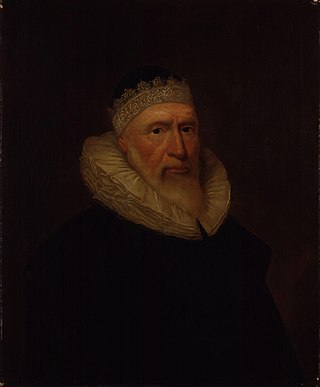Related Research Articles

Frances Sheridan was an Anglo-Irish novelist and playwright.

Sir Julius Caesar was an English lawyer, judge and politician who sat in the House of Commons at various times between 1589 and 1622. He was also known as Julius Adelmare.

Edmund Grey, 1st Earl of Kent, KB, English administrator, nobleman and magnate, was the son of Sir John Grey, KG and Constance Holland. His main residence was at Wrest near Silsoe, Bedfordshire.

Thomas Sackville, 1st Earl of Dorset was an English statesman, poet, and dramatist. He was the son of Richard Sackville, a cousin to Anne Boleyn. He was a Member of Parliament and Lord High Treasurer.

William Parr, Marquess of Northampton, Earl of Essex, 1st Baron Parr, 1st Baron Hart, was the only brother of Queen Catherine Parr, the sixth and final wife of King Henry VIII. He was a "sincere, plain, direct man, not crafty nor involved", whose "delight was music and poetry and his exercise war" who co-authored a treatise on hare coursing. He was in favour with Henry VIII and his son Edward VI, under whom he was the leader of the Protestant party, but having supported the desire of the latter to be succeeded by the Protestant Lady Jane Grey, was attainted by Edward's Catholic half-sister, Queen Mary I. He was restored by her Protestant half-sister, Queen Elizabeth I. He married thrice but died without issue.

James Pettit Andrews was an English historian and antiquary.

Edward Seymour, 1st Earl of Hertford, 1st Baron Beauchamp, KG, of Wulfhall and Totnam Lodge in Great Bedwyn, Wiltshire, of Hatch Beauchamp in Somerset, of Netley Abbey, Hampshire, and of Hertford House, Cannon Row in Westminster, is most noted for incurring the displeasure of Queen Elizabeth I by taking part in more than one clandestine marriage.
Sir Edward Saunders was an English judge and Chief Justice of the Queen's Bench.

John Closterman was a Westphalian portrait painter of the late 17th and early 18th centuries. His subjects were mostly European noblemen and their families.
William John Law (1786–1869) was a British judge of the 19th century.
Harriet Anne Scott, Lady Scott (1816–1894), was a British novelist, born in India, and of Scottish descent.

Sir Robert Throckmorton, KG, of Coughton Court in Warwickshire, was a Member of Parliament and a distinguished English courtier. His public career was impeded by remaining a Roman Catholic.

Priscilla Anne Fane, Countess of Westmorland, styled Lady Burghersh between 1811 and 1841, was a British linguist and artist.
George Baker (1781–1851), topographer and historian, was a native of Northampton, England.

Lady Elizabeth "Betty" Germain was a wealthy English aristocrat and courtier, a philanthropist and collector of antiquities, who corresponded with literary and political figures.
Francis Tate (1560–1616) was an English antiquary and politician, Member of Parliament for Northampton and Shrewsbury.
Katherine Thomson (1797–1862) was an English writer, known as a novelist and historian.
Dorothy Kitson, later Dorothy, Lady Pakington, was the daughter of Sir Thomas Kitson, a wealthy London merchant and the builder of Hengrave Hall in Suffolk. Her first husband was Sir Thomas Pakington, by whom she was the mother of Queen Elizabeth I's favourite, Sir John "Lusty" Pakington. After Sir Thomas Pakington's death, she married Thomas Tasburgh. She was one of the few women in Tudor England to nominate burgesses to Parliament and to make her last will while her husband, Thomas Tasburgh, was still living. Her three nieces are referred to in the poems of Edmund Spenser.
Rose Lok was an English businesswoman and Protestant exile during the Tudor period. At the age of eighty-four, she wrote an account covering the first part of her life.
Matilda Anne Mackarness was an English novelist of the 19th century, primarily writing children's literature.
References
- Cooper, Thompson (1885). . In Stephen, Leslie (ed.). Dictionary of National Biography . Vol. 03. London: Smith, Elder & Co.
 This article incorporates text from a publication now in the public domain : "Baker, Anne Elizabeth". Dictionary of National Biography . London: Smith, Elder & Co. 1885–1900.
This article incorporates text from a publication now in the public domain : "Baker, Anne Elizabeth". Dictionary of National Biography . London: Smith, Elder & Co. 1885–1900.